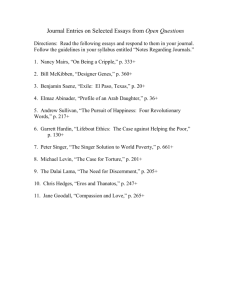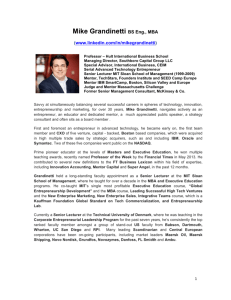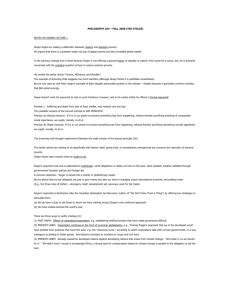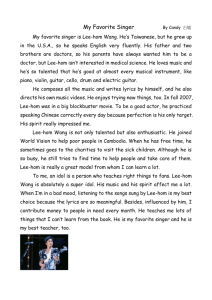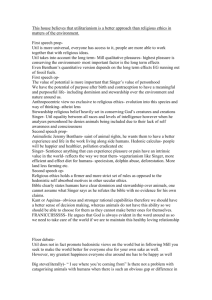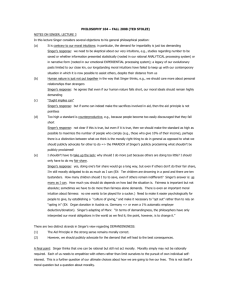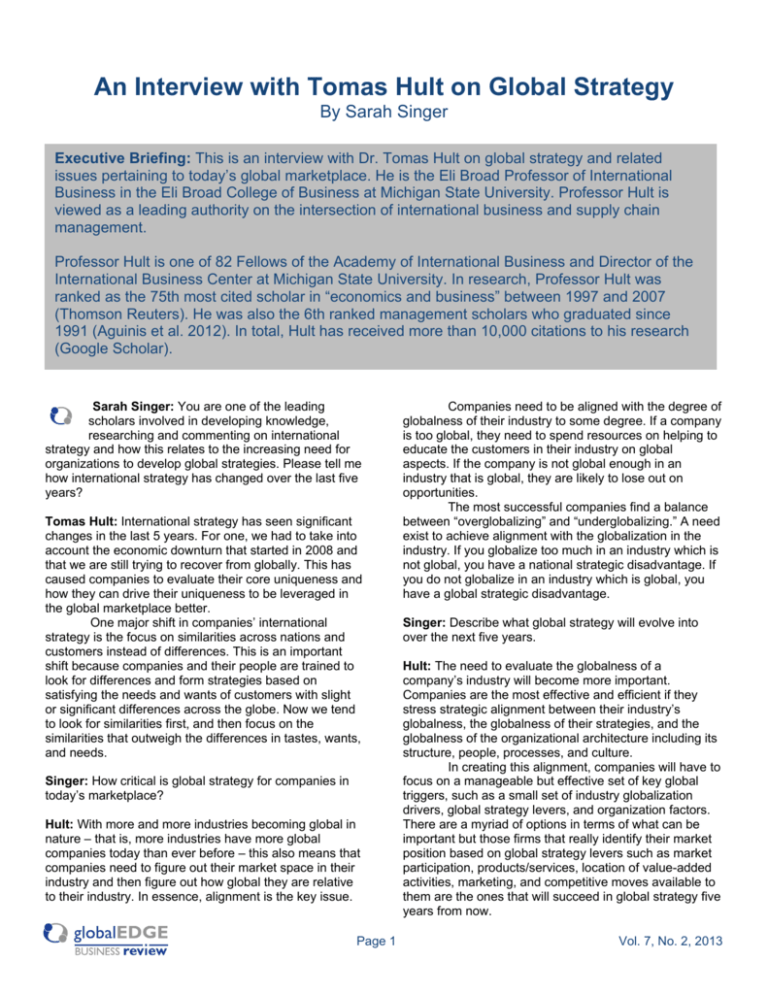
An Interview with Tomas Hult on Global Strategy
By Sarah Singer
Executive Briefing: This is an interview with Dr. Tomas Hult on global strategy and related
issues pertaining to today’s global marketplace. He is the Eli Broad Professor of International
Business in the Eli Broad College of Business at Michigan State University. Professor Hult is
viewed as a leading authority on the intersection of international business and supply chain
management.
Professor Hult is one of 82 Fellows of the Academy of International Business and Director of the
International Business Center at Michigan State University. In research, Professor Hult was
ranked as the 75th most cited scholar in “economics and business” between 1997 and 2007
(Thomson Reuters). He was also the 6th ranked management scholars who graduated since
1991 (Aguinis et al. 2012). In total, Hult has received more than 10,000 citations to his research
(Google Scholar).
Sarah Singer: You are one of the leading
scholars involved in developing knowledge,
researching and commenting on international
strategy and how this relates to the increasing need for
organizations to develop global strategies. Please tell me
how international strategy has changed over the last five
years?
Tomas Hult: International strategy has seen significant
changes in the last 5 years. For one, we had to take into
account the economic downturn that started in 2008 and
that we are still trying to recover from globally. This has
caused companies to evaluate their core uniqueness and
how they can drive their uniqueness to be leveraged in
the global marketplace better.
One major shift in companies’ international
strategy is the focus on similarities across nations and
customers instead of differences. This is an important
shift because companies and their people are trained to
look for differences and form strategies based on
satisfying the needs and wants of customers with slight
or significant differences across the globe. Now we tend
to look for similarities first, and then focus on the
similarities that outweigh the differences in tastes, wants,
and needs.
Singer: How critical is global strategy for companies in
today’s marketplace?
Hult: With more and more industries becoming global in
nature – that is, more industries have more global
companies today than ever before – this also means that
companies need to figure out their market space in their
industry and then figure out how global they are relative
to their industry. In essence, alignment is the key issue.
Page 1
Companies need to be aligned with the degree of
globalness of their industry to some degree. If a company
is too global, they need to spend resources on helping to
educate the customers in their industry on global
aspects. If the company is not global enough in an
industry that is global, they are likely to lose out on
opportunities.
The most successful companies find a balance
between “overglobalizing” and “underglobalizing.” A need
exist to achieve alignment with the globalization in the
industry. If you globalize too much in an industry which is
not global, you have a national strategic disadvantage. If
you do not globalize in an industry which is global, you
have a global strategic disadvantage.
Singer: Describe what global strategy will evolve into
over the next five years.
Hult: The need to evaluate the globalness of a
company’s industry will become more important.
Companies are the most effective and efficient if they
stress strategic alignment between their industry’s
globalness, the globalness of their strategies, and the
globalness of the organizational architecture including its
structure, people, processes, and culture.
In creating this alignment, companies will have to
focus on a manageable but effective set of key global
triggers, such as a small set of industry globalization
drivers, global strategy levers, and organization factors.
There are a myriad of options in terms of what can be
important but those firms that really identify their market
position based on global strategy levers such as market
participation, products/services, location of value-added
activities, marketing, and competitive moves available to
them are the ones that will succeed in global strategy five
years from now.
Vol. 7, No. 2, 2013
Singer: Does developing an international strategy, or
even a global strategy, matter for a small or medium
sized business?
Hult: Global strategy is more important now for all sizes
of companies because the emerging reality for global
companies is on a focused set of smaller number of
global businesses within an integrated global economy.
That is, successful global companies of the past used to
be large multinational corporations that had a great
breadth of product lines. Successful global companies
today come in all sizes.
But, a key feature for the small and medium
companies that are successful globally is that they adopt
a global strategy, focus on a much smaller set of
products, and strategically identify a preferred
intermarket segment across countries. This means that
small and medium sized companies implementing a
global strategy do not sell to large market shares in a
relatively small set of countries, they focus on a larger set
of countries with a smaller market share in each but
where their core uniqueness can be stressed without
much adaptations because of the markets. Their
strategies are driven by identifying similarities in wants
and needs among global customers instead of satisfying
customers based on their different needs.
Singer: How has the trade volume and landscape of the
global marketplace changed in the past five years?
Hult: Trade volume across the globe has really
exponentially increased in the last five years. In fact, the
volume has about doubled since 2005 and about tripled
since 2000. These are really amazing numbers that
stress the need to be globally active for small, medium,
and large companies. And, small, medium, and large
companies have an opportunity to implement effective
and efficient global strategies to be globally active,
especially where a focus is on similarities among
customer segments that outweigh differences, and where
the target market takes the form of an intermarket
segment with a small number of products being sold
instead of going after larger portions of country markets
with more product choices.
involves major global competitors but they act very locally
in their book offerings. The furniture industry on the other
hand only has some global competitors and none of them
are really using effective global strategy to go after
customer worldwide (with perhaps the exception of
IKEA).
On the other hand, the computer industry, cell
phone industry, and credit card industry are all rather
global and predicted to become even more global.
Companies in those industries that try to offer very local
products are going to have a tough time competing.
Singer: What are the critical elements of a successful
global strategy?
Hult: For any given company and industry, there are
literally hundreds of strategic choices and options. But
the key global strategy levers that all companies
operating globally need to focus on are market
participation, products/services, locating value-added
global activities, marketing, and competitive moves.
These five global strategy levers are the key ones that
make global companies thrive – assuming they evaluate
each and make appropriate development and
implementation decisions regarding each. My guess is
that 80 percent or more of a global company’s success
comes from effective and efficient evaluation,
development, and implementation of these five global
strategy levers.
Singer: Can you provide a recent real-world example of
a business changing or executing their global strategy
that was successful?
Hult: A number of firms are focused on global strategies
these days. One example is Nestlé. Nestlé conducts
research and development (R&D) on a global scale with
some 30 research and development facilities worldwide.
Much of Nestlé’s current R&D efforts are concerned with
creating global products that are easily adaptable to
different locations. As a result, based on its product and
positioning strategy, Nestlé is often considered a local
company in the many countries it has operations even
though it has developed and implemented a universally
applicable global strategy.
Singer: And an example that was unsuccessful or
perhaps an example of a company that made a wrong
decision as a result of not having a cohesive international
strategy?
Singer: What is the significance for various industries
and businesses and how they will develop strategy for
the next five years?
Hult: It is clear that industries differ in the degree of
globalness that they exemplify today, and what they are
predicted to be in the next few years. For example, the
furniture market and the book publishing market are both
rather domestic today and perhaps predicted to stay
somewhat domestic in the next few years.
They are domestic for different reasons though.
Book publishing actually
Page 4
Hult: It is hard to talk about bad companies making
significant mistakes. But let me mention a few examples
of companies that right now are in critical decisionmaking mode as far as global strategy or should be if
they are not seeing it. My research shows that:
Vol. 7, No. 2, 2013
American Express is pretty good at developing a global
strategy but, as an organization, they have major
drawbacks in implementing such global strategy
effectively. In effect, there are too many positive and
negative influencers within the infrastructure of American
Express, making it very hard to predict their global
strategy effectiveness.
FedEx is very driven by its market participation –
they really claim to be everywhere. But their organization
structure ends up having a negative influence on their
market participation. So, they cannot fully leverage that
they are everywhere because of their limitations in
structure.
Nokia appears to have some global issues with
their management processes. They negatively affect
Nokia’s market participation and their overall effect on
performance. Globally, they need to improve their
management processes to maintain their current global
success.
Singer: What job roles would normally be associated
with developing an international or global strategy in
large organizations? And in medium sized organizations?
And in small organizations?
Hult: The differences between small, medium, and large
companies operating within a global strategy can be
significant but also not significant at all. Ideally, the
leverage points – such as what markets to participate in,
what products to offer, where to locate value-added
activities, how to do global marketing, and what
competitive moves to consider – are all done by all sizes
of companies.
More likely, small companies focus their efforts
on more exporting than setting up shop overseas or
integrated global networks and strategy. In such cases,
home country nationals often run local marketing
subsidiaries.
Medium-sized companies engage people who
travel a bit more than the small companies’ people do,
but not much more; they have nationals run local
businesses; and they have a select set of professional
expatriates from the company’s home base.
Large companies engage people who can and
want to have multicountry careers; employ many more
foreign nationals in home and third countries; and expect
more of their employees to travel throughout the globe
extensively.
Singer: You have developed an effective Global Strategy
Framework in your most recent book titled Total Global
Strategy [published in 2012 together with George Yip by
Pearson Prentice Hall]. Describe how topics and
concepts presented in the Global Strategy Framework
can be applied on the job once a person understands the
concepts in the book. Please give some recent examples
from your work and studies.
Page 3
Hult: The global strategy framework that we cover in
Total Global Strategy centers on the key trigger points for
companies to be successful in the global marketplace.
We cover four industry globalization drivers (market, cost,
government, and competitive); five global strategy levers
(market participation, products/services, locating value
added activities, marketing, and competitive moves); and
four organization factors (structure, management
processes, people, and culture). These 13 drivers, levers,
and factors are what make most global companies
successful. Readers of TGS will learn the drivers, levers,
and factors and how to measure and implement them
effectively in their companies.
The global strategy framework has been studied
in a number of companies – such as ABB, American
Express, Cemex, Daimler, Dell, FedEx, Microsoft, Nokia,
Skandia, and Swatch – and the results have been
tracked. The global strategy framework has also been
incorporated in some 60-70 large multinational
corporations such as FedEx, Ford, IBM, Masco,
Steelcase, and Textron – along with a large number of
small and medium-sized companies across the U.S. but
with a focus on Michigan, Tennessee, and Florida.
Singer: Can you explain how managers at every level of
an organization could benefit from your book on Total
Global Strategy?
Hult: Global strategy needs to permeate the fabric of an
organization to effectively build it into a global company.
The global strategy levers we discuss are most
effectively evaluated, developed, and implemented at the
business unit level – but within a corporate strategyfocused infrastructure.
This means that corporate C-suite individuals,
business unit managers and individuals, country-level
employees, and front-line service employees need to
have an understanding of the global strategy levers, their
importance within the organizational system that each
employee operates within, and how the organization can
effectively implement a global strategy at the corporate,
business unit, and functional levels.
Singer: Describe the most important take away from
Total Global Strategy.
Hult: The key takeaway from TGS is a proven global
strategy framework that is working for many global
companies. The secondary takeaways include which key
triggers lead to success for global companies, how to
measure them, and how to strategically align them with a
company’s industry and organizational capabilities for
maximum global impact.
Singer: How will Total Global Strategy help someone
gain a competitive advantage for their career?
Vol. 7, No. 2, 2013
Hult: I am a great believer that the process of doing
global business is the key to learning about global
markets and achieve success. Learning depth knowledge
about a country, language, or specific issue may be
important if such a narrow focus is critical to success.
But, for example, learning Swedish (my native language)
is not important for people who are not going to operate
in Sweden on a regular basis.
TGS will make each reader of the book have a
greater degree of global competence but, most
importantly, have a process understanding of what it
takes to operate effectively in the global marketplace. If
you have a process for better understanding what are the
key aspects of running a global company, what are the
key aspects of creating value in the global supply chain,
and what are the key similarities and differences to focus
on cross-culturally – you will be a winner as a global
manager.
Singer: How important is it for business professionals to
understand international strategy and global strategy and
how they impact their strategic decision making?
Hult: It is incredibly critical for business professionals to
understand global strategy to effectively leverage their
companies’ unique core and, by implication, take
advantage of the companies’ market potential which
leads to long-term success.
In essence, we need to be trained better at
looking for customers’ similarities in needs and wants,
Page 4
figure out when those similarities outweigh the
differences, and then drive the key trigger points of global
strategy levers available to the company to success.
The most important global competence business
professionals need to have is the ability to evaluate the
degree of globalness of their industry, their own
globalness in strategy and organization vis-à-vis the
industry, and then create an effective and efficient
alignment with the industry as it is predicted to be for the
next several years. Such global competence takes a
great deal of knowledge of the right trigger points to
evaluate (i.e., global strategy levers) along with foresight
to predict the degree of globalness of their industry
continually to always maintain an appropriate global
alignment. gBR Article 07-02, Copyright 2013.
About the Author
Dr. Sarah Singer is the Managing Editor of the
globalEDGE Business Review and the Assistant Director
of the International Business Center at Michigan State
University (MSU-CIBER). Sarah can be reached at
singersm@msu.edu. Dr. Tomas Hult, the Eli Broad
Professor of International Business in the Eli Broad
College of Business at Michigan State University, can be
contacted at hult@msu.edu or 517-353-4336. More
information about Tomas Hult can also be found at
tomashult.com. His most recent book is Total Global
Strategy with George Yip (published in 2012 by Pearson
Prentice Hall).
Vol. 7, No. 2, 2013

